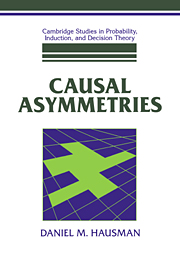Book contents
- Frontmatter
- Contents
- List of Figures
- Acknowledgments
- Introduction: Causation and its Asymmetries
- 1 Metaphysical Pictures and Wishes
- 1* Transfer Theories
- 2 Is Causation a Relation Among Events?
- 3 Causation, Regularities, and Time: Hume's Theory
- 4 Causation and Independence
- 4* Causation, Independence, and Causal Connection
- 5 Agency Theory
- 5* Causal Generalizations and Agency
- 6 The Counterfactual Theory
- 6* Independence and Counterfactual Dependence
- 7 Counterfactuals, Agency, and Independence
- 7* Agency, Counterfactuals, and Independence
- 8 Causation, Explanation, and Laws
- 8* Causation, Explanation, and Independent Alterability
- 9 Probabilistic Causation
- 10 Causation and Conditional Probabilities
- 10* Causal Graphs and Conditional Probabilistic Dependencies
- 11 Intervention, Robustness, and Probabilistic Dependence
- 11* Interventions and Conditional Probabilities
- 12 Operationalizing and Revising the Independence Theory
- 12* Probability Distributions and Causation
- 13 Complications and Conclusions
- Appendix A Alphabetical List of Propositions
- Appendix B List of Theorems
- References
- Index
7* - Agency, Counterfactuals, and Independence
Published online by Cambridge University Press: 20 April 2010
- Frontmatter
- Contents
- List of Figures
- Acknowledgments
- Introduction: Causation and its Asymmetries
- 1 Metaphysical Pictures and Wishes
- 1* Transfer Theories
- 2 Is Causation a Relation Among Events?
- 3 Causation, Regularities, and Time: Hume's Theory
- 4 Causation and Independence
- 4* Causation, Independence, and Causal Connection
- 5 Agency Theory
- 5* Causal Generalizations and Agency
- 6 The Counterfactual Theory
- 6* Independence and Counterfactual Dependence
- 7 Counterfactuals, Agency, and Independence
- 7* Agency, Counterfactuals, and Independence
- 8 Causation, Explanation, and Laws
- 8* Causation, Explanation, and Independent Alterability
- 9 Probabilistic Causation
- 10 Causation and Conditional Probabilities
- 10* Causal Graphs and Conditional Probabilistic Dependencies
- 11 Intervention, Robustness, and Probabilistic Dependence
- 11* Interventions and Conditional Probabilities
- 12 Operationalizing and Revising the Independence Theory
- 12* Probability Distributions and Causation
- 13 Complications and Conclusions
- Appendix A Alphabetical List of Propositions
- Appendix B List of Theorems
- References
- Index
Summary
Independence and a Token Version of Agency Theory
Analogous to the conditions in chapter 5 let us define:
AT (Agency theory) a causes b if and only if a and b are distinct, and with respect to some set of (actual) events E, if a had come about as a result of a direct manipulation, then that intervention would be a cause of b.
If one wants to make the circularity less blatant, one can replace the last nine words with “then that intervention would be nomically connected to b,” and all the same results hold. As was the case with ATg, the quantification over a set of events is necessary, because the notion of a direct manipulation is relativized to a set of events.
DHI (Definition of a human intervention) i is a direct human intervention or manipulation that brings about a only (with respect to a set of events E of interest) if and only if (1) i is distinct from every event in E, (2) i is a direct cause of a, (3) the structure of the causal relations between a and its effects is the same when a is caused by i as when there is no intervention, (4) i has no causal connections to any other events in E except those that follow from its being a direct cause of a, and (5) i is a human action.
- Type
- Chapter
- Information
- Causal Asymmetries , pp. 151 - 155Publisher: Cambridge University PressPrint publication year: 1998



